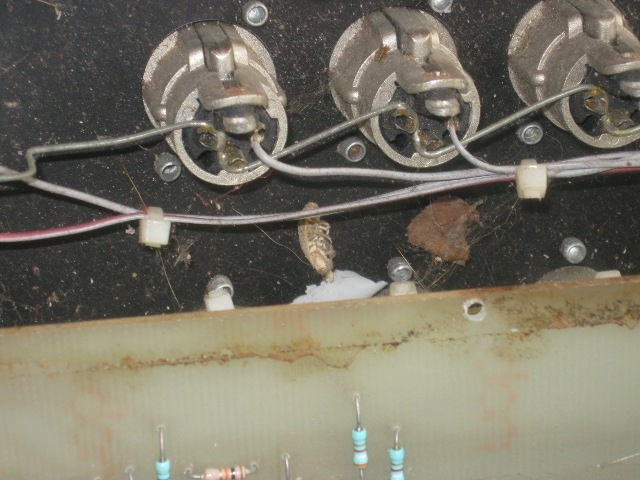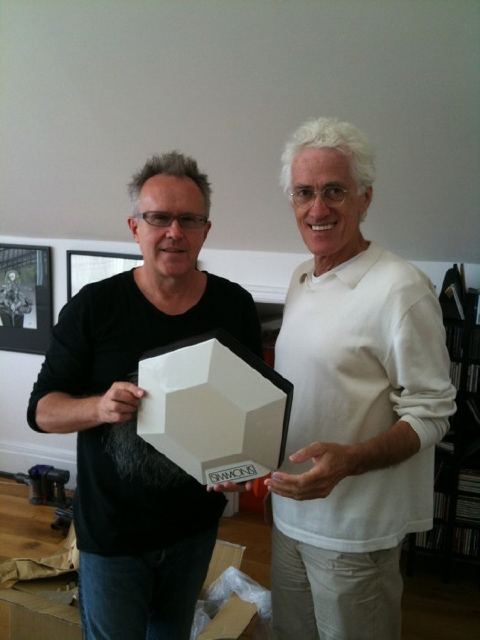Thank you for 500 guestbook posts on simmonsmuseum.com (SPAM of course not included), mostly nice feedback, some support requests, some suggestions, … The first entry was posted on July 10th, 2005 which is quite a lot of time. Statistically about 100 entries per year or one entry every 3-4 days. That proves the interest in this topic and keeps me motivated to continue.
Thanks again!
Wolfgang
Archive for the ‘Uncategorized’ Category
500 guestbook entries
Tuesday, October 19th, 2010SDS9 manual
Friday, September 17th, 2010There are some Simmons items for which I had to wait several years to get a hand on. I am not talking about one of 250 SDX, one of 100 SDS3, one of 15 Suitcase Kits. No, I am talking about the manual of the most common Simmons kit ever built: The SDS9 manual. While I got the German version already in 2005, I had to wait another 5 years to get the english version. Another tiny piece in the jigsaw. As the SDS9 is not that easy to program, I hope it will provide relief to its owners 🙂

The Stepp guitar
Thursday, August 5th, 2010The internet is full of coincidences. Watching the Kate Bush video “Experiment IV” I was already enthusiastic about the Simmons kit when I saw the guitar player’s synth guitar.
I was sure that I have seen this before and I was right! It was the “Stepp Guitar” synthesizer.

taken from Complete Simmons Drum Book
In the “Complete Simmons Drum Book” Bob Henrit writes about the “Stepp Guitar”:
“Over the last few years when I’ve been visiting either of the Simmons factories, I’ve frequently been confronted by a very futuristic guitar which has always been whisked out of sight the moment I’ve asked any questions about it. However, this bunch of hi-tech components has finally emerged as the ‘Stepp’ guitar, which now has only tenuous links with Simmons, to the sort of critical acclaim which greeted the original SDS.5 drum set. Being the go-ahead company that they are, Simmons have frequently carried out, via their ‘R and D’ department, feasibility studies on a number of percussion, and non-percussion-linked musical properties. They’ve not only looked into guitars, but also keyboards and the like.
Back in the early days at Abbey Mill, a chap called Steve Randall came along wit a sketch of a guitar on the back of a cigarette packet. This was his dream and he felt that Dave Simmons might well be able to help. They talked about the project and Dave experimented with an ARP 2600 and some pickups and applied what knowledge he had about voicing to get the equipment to produce guitar-like sound. From there he built prototypes, and then ran into so many problems that it became obvious very quickly that he’d either have to devote all of his time to the project, or none at all.
So, even though there were many times that the guitar could have been a total of Simmons venture, the board decided to pass on it in favour of drums. Steve Randall consequently took their joint work to a Cambridge consultant where it has resided ever since. Dave says that the formative ideas where mostly Steve’s, and post-Simmons he’d been searching for some time for very good brains, as well as a large amount of fonance to make the dream a reality. It has not, I understand been easy for him and has necessitated a great deal of stubborn determination to get this revolutionary guitar into the market-place. The guitar, with its inherent complicated technology, was beset by many problems which were unfortunately not solved overnight. Dave Simmons says that, had his company remained involved, they would not have had sufficient resources left to fight their other drum battles. Obviously it would have been a great coup to have Simmons hi-tech drums and guitars, but the company decided they had a big enough battle on their hands building the market for drums, let alone guitars.
Just like Simmons drums the ‘Stepp’ guitar is unique. It’s not a bastardisation of an acoustic instrument, and they haven’t simply mounted a pickup and endeavoured to pluck control signals from the strings. They’ve taken a sideways look at the whole soncept. In their philosophy they parallel Simmons who always maintained that if you’re going to do something different, then you might just as well go the whole hog.
From bitter experience Dave knows that there are going to be guitarists who critisise the ‘Stepp’ in the same way that drummers originally derided the SDS.5 drums. They’ll probably say why should they pay a great deal of money for an instrument which sounds something like the guitar they already own? the fact is, if they’ve managed to make it sound like a guitar and play like one, then they’ve more or less ‘cracked it’. It is relatively simple then to persuade it to sound like an organ, a trumpet or perhaps even a drum!
…
While we discussed the guitar, Dave admitted that some of the problems Simmons have had with their products have been of their own making; they were simply too complicated. He feels that they ran perhaps too far ahead of the general public. It’s frustrating for the company, but they can understand the public too. For ‘Stepp’ guitar to be successful the people behind it will have to realise this. The player will want to pick it up, plug it in and scintillate. Because of dummy strings he may have to modify his technique a little, but otherwise one would have thought all the lessons learned from marketing Simmons electronic drums, could be just as succinctly and valuably applied to the ‘Stepp’ guitar.”
(Steve Randall performing on his Stepp guitar)
a dignified evening of life (part 2)
Sunday, July 11th, 2010Some posts ago I reported about the rusty Musicaid SDSV frame SN#72. Today I had the opportunity to disassemble the device. While the outer chassis has obviously suffered from humidity, the internal cicuit boards look pretty good. All soldering joins seem to be ok. Only the socket of the fuse and the power LED need to be replaced. No big deal.

The SDSV: consisting of only a handful of electronic parts, not really rocket science, but somehow mean

this picture reminds me of my first car, a 1970 Volkswagen Bus T2 right after purchase

The rust and old lacquer has been sanded away

the sanded surface grounded with a special undercoat

some dead insect….
The next step will be to replace the fuse socket and power LED, then I will assemble all parts again for testing. Stay tuned
Photo Shooting
Friday, July 9th, 2010Instead of waiting until my gear has rottened in my basement, I rather prefer to place it in the limelight. Yesterday I had the opportunity in the photo atelier of a long time friend:








Howard Jones? THE Howard Jones?
Tuesday, July 6th, 2010When Howard Jones released his first hit single “What Is Love?” in 1983 I purchased the entire album. This initial smash hit was followed by countless more chart hits. I was told that when he used to perform he integrated several Simmons gear into his setup, for example the SDS6 step sequencer and SDSV (the emphasis is on “I was told…”).
For whatever reason Howard Jones was looking for two Simmons pads, I assume in order to integrate them into the percussion setup of his upcoming shows. One of the former Simmons protargonists forwarded my email adress and so I got his request purchasing two SDS9 pads last week. (Un-)Fortunately I don’t sell any gear from my collection. But I offered him to send two pads for free if he would return some Simmons gossip and pictures of the setup for my blog. He was very happy about my offer, but his counter-offer said that he would invite me for his Indigo2 show in London on November 6th. And I will join this show together with my wife!
Today the pads arrived in England. Howard kindly documented the arrival with a picture of him, together with none less than Rupert Hine, world famous producer, posing with my SDS9 pads. Thanks guys! Another story for my grandchildren!

a dignified evening of life
Saturday, June 12th, 2010What’s even more fascinating than a Simmons SDSV? Exactly: A Musicaid SDSV. But these first steps of hexagonal history are so hard to find. I got an empty Musicaid SDSV frame, serial number #71, in absolute pathetic condition: rusty and filled with (vintage) British autumn leaves. I assume it has spend the last 25 years in a humid barn or basement. However no SDSV is to be scrapped. I was truely reminded of two years of my life, 1989-1991 when I had been working in a retirement home where I learned: “Everybody has a claim to a dignified evening of life”




I swear this oldie will live to see a second birth. My Musicaid pads need something to plug in. Stay tuned…
The mathematics of the hexagon
Monday, June 7th, 2010At school I was a nerd. Especially interested in mathematics and physics. Mathematics are based on theory and models. Perfect and clean: geometry, symmetry. Not as fallible as life. No wonder I had been immediately fascinated by Simmons drums: A ballanced form. The sound: calculable. No unknown quantities like acoustic drums provide. For those who want to learn more about the hexagon’s properties, I like to refer to the Wikipedia Entry about hexagons
SDSV in the "Deutsches Museum" in Munich
Sunday, May 16th, 2010The “Deutsches Museum” in Munich/Germany is for sure Germany’s most important museum for technical innovations (followed by Simmonsmuseum… :-)). When I was a child, I remember several visits where I was fascinated by exhibits like aircrafts, moon vehicals, etc… . I cannot deny that recently I was pretty astonished to hear that even the SDSV made it there.
The board right in front of the SDSV says:
“In 1979, Dave Simmons invented the first drum synthesizer. Series production of this synthesiser began in 1980. This instrument was played like an acoustic drum, but offered much bigger volume and differentiation.
Thanks to its outstanding sound quality, this instrument was very high in demand. The small company rapidly grew to become the most important manufacturer of electric drums in the world.
Sounds were produced by various generators and passed through an adjustable, voltage-controlled filter. Depending on how hard the drum was hit, an amplifier controlled the output signal and intensity.
5 channel drum synthesiser
bass, snare and 3 tom modules
could be expanded to 7 modules”
The picture is taken from Wikimedia Commons
